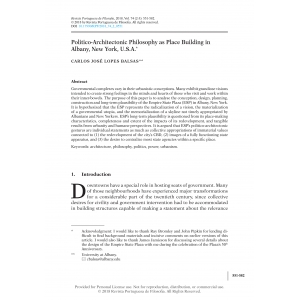Abbott, Carl. ‘Symposium The Future of the Ceremonial City: A Third Century of Planning for Washington, D.C.’, Journal of the American Planning Association 68, no. 2 (2002): 125–27. doi:10.1080/01944360208976257.
AICP. The Study Manual for the Comprehensive Planning Examination of the American Institute of Certified Planners. Memphis: The University of Memphis and American Planning Association, 1994.
Alexander, Michelle. The New Jim Crow: Mass incarceration in the age of colorblindness. New York: New Press, 2010.
Angotti, Tom. New York for Sale: Community planning confronts global real estate. Cambridge: The MIT Press, 2008.
Berman, Marshall. All That Is Solid Melts Into Air: The experience of modernity. New York: Penguin Books. 1988.
Bleecker, Samuel, Ezra Stoller, and George Dudley. The Politics of Architecture: A perspective on Nelson A. Rockefeller. New York: Rutledge Press, 1981.
Boyle, Mark, and Robert Rogerson. ‘Power, discourses and city trajectories’, in Handbook of Urban Studies edited by Ron Paddison, 402–16. London: Sage Publications, 2001.
Castello, Lineu. Rethinking the Meaning of Place: Conceiving place in architecture-urbanism. New York: Ashgate, 2010.
Damasio, António. Self Comes to Mind: Constructing the conscious brain. New York: Random House, 2010.
Ellin, Nan. Postmodern Urbanism. Revised ed. New York: Princeton Architectural Press, 1999.
Farrell, William. ‘State Mall, Rising in Albany, Becomes a Campaign Issue’, New York Times (August 18, 1970), 37, 45.
Ford, Larry. ‘World Cities and Global Change: Observations on monumentality in urban design’, Eurasian Geography and Economics 49, no. 3 (2008): 237–62. doi:10.2747/1539-7216.49.3.237.
Foucault, Michael. ‘Governamentality’, in The Foucault Effect edited by Peter Miller, Colin Gordon, and Graham Burchell, 87–104. Chicago: University of Chicago Press, 1991.
Gans, Herbert. The Urban Villagers: Group and class in the life of Italian-Americans. New York: Free Press of Glencoe, 1962.
Goldberger, Paul. On the Rise: Architecture and design in a postmodern age. New York: Penguin Books, 1983.
Goldin, Milton. ‘Nelson Rockefeller and the Politics of Philanthropy’, History Today 40 (1990): 39–45.
Goodsell, Charles. The Social Meaning of Civic Space: Studying political authority through architecture. Lawrence: University Press of Kansas, 1988.
Gordon, David. Planning Twentieth Century Capital Cities. London: Routledge, 2006.
Grondahl, Paul. Mayor Corning: Albany Icon, Albany Enigma. Albany: Washington Park Press. 1997.
Grubbauer, Monika. ‘“Global” architecture as a contradictory signifier: Lessons from Hamburg’s and Vienna’s urban megaprojects’, in Urban Megaprojects: A Worldview edited by Gerardo Del Cerro, 185–209. Bingley: Emerald Group, 2013.
Hayes, Nick. ‘Two tales of the city? Probing twentieth-century urban and architectural history’, Journal of Contemporary History 37, no. 4 (2002): 665–74. 0022–0094(200210)37:4;665–674;027961.
Jencks, Charles. ‘The iconic building is here to stay’, City 10, no. 1 (2006): 3–20. doi: 10.1080/13604810600594605.
Kennedy, William. O Albany! New York: Penguin Books, 1983.
Keough, Brian. ‘Politics as Usual or Political Change: The War on Poverty’s Community Action Program in Albany, N.Y., 1959–1967’, Afro-Americans in New York Life and History 36, no. 2 (2012): 37–65.
Koolhaas, Rem. Delirious New York – A retrospective Manifesto for Manhattan. New York: The Monacelli Press. 1994.
Krueckeberg, Donald. The American Planner: Biographies & Recollections. 2nd ed. New Brunswick: Center for Urban Policy Research. 1994.
Lees, Lynn. ‘The challenge of political change: Urban history in the 1990s.’ Urban History 21, no. 1 (1994): 7–19. doi: 10.1017/S0963926800010671.
Lengellé, Jean, Caroline Andrew, and John Taylor. Capital Cities/Les Capitales – International Perspectives/Perspectives Internationales. Ottawa: Carleton University Press. 1993.
Lewi, Hannah, and Gary Wickham. ‘Modern urban government: A Foucaultian perspective.’ Urban Policy and Research 14, no. 1 (1996): 51–64. doi: 10.1080/08111149608551612.
Logan, Cameron. ‘Beyond a boundary: Washington’s historic districts and their racial contents’, Urban History Review/Revue d’Histoire Urbaine 41, no. 1 (2012): 57–68. doi: 10.7202/1013764ar.
Madden, David. ‘On Marshall Berman (1940–2013): A radical New York intellectual: Introduction’, City 19, no. 1 (2015): 102–03. doi: 10.1080/13604813.2014.991527.
Marris, Peter. The Politics of Uncertainty: Attachment in Private and Public Life. New York: Routledge, 1996.
Mayo, James, and Nils Gore. ‘Confronting the terrain of politics in architectural practice: Assessing strengths and weaknesses’, Journal of Architectural and Planning Research 30, no. 3 (2013): 244–63.
McEneny, John. Albany: Capital city on the Hudson. Sun Valley: American Historical Press, 2006.
McGuirk, Justin. Radical Cities: Across Latin America in search of a new architecture. New York: Verso, 2014.
Millington, Gareth. ‘Remaining faithful to the city: Marshall Berman’s provocative optimism’, City 19: no. 1 (2015): 112–20. doi: 10.1080/13604813.2014.991174.
Montès, Christian. American Capitals a Historical Geography. Chicago: The University of Chicago Press, 2014.
Monteyne, David. ‘Boston City Hall and a history of reception’, Journal of Architectural Education 65, no. 1 (2011): 45–62. doi: 10.1111/j.1531-314X.2011.01171.x.
Nesbitt, Kate. Theorizing a New Agenda for Architecture: An anthology of architectural theory 1965–1995. New York: Princeton Architectural Press, 1996.
Newhouse, Victoria. Wallace K. Harrison, Architect. New York: Rizzoli, 1989.
Orueta, Fernando, and Susan Fainstein. ‘Symposium the New Mega-Projects: Genesis and Impacts’, International Journal of Urban and Regional Research 32, no. 4 (2008): 759–67. doi: 10.1111/j.1468-2427.2008.00829.x.
Paley, Mary, John Romeo, and Patrick Bulgaro. The Neighborhood that Disappeared. Albany: OmiKronics, 2014.
Pati, Debajyoti, Mallika Bose, and Craig Zimring. ‘Rethinking openness: Courthouses in the United States’, Journal of Architectural and Planning Research 24, no. 4 (2007): 308–24.
Pham, Adele, Messiah Rhodes, Bhawin Suchak, Ira McKinley, and Michelle Alexander. The Throwaways – Film. New York: Social Change in Mind Productions, 2014.
Pipkin, John. ‘“Chasing Rainbows” in Albany: City Beautiful, City Practical 1900–1925’, Journal of Planning History 7, no. 4 (2008): 327–53. doi: 10.1177/1538513208319259.
Redstone, Louis. The New Downtowns: Rebuilding business districts. New York: McGraw-Hill Book Company, 1976.
Roseberry, C. Capitol Story. 3rd ed. Albany: State University of New York Press, 2014.
Sandercok, Leonie. Towards Cosmopolis: Planning for multicultural cities. Chichester: John Wiley & Sons, 1998.
Scully, Vincent. American Architecture and Urbanism. New York: Henry Holt and Company, 1969.
Sklair, Leslie. ‘Iconic architecture and capitalist globalization’, City 10, no. 1 (2006): 21–47. doi: 10.1080/13604810600594613.
Sklair, Leslie. ‘The role of iconic architecture in globalizing urban megaprojects’, in Urban Megaprojects: A Worldview edited by Gerardo del Cerro, 161–183. Bingley: Emerald Group, 2013.
Smith, Chris. ‘Monumentality in Urban Design: The Case of China’, Eurasian Geography and Economics 49, no. 3 (2008): 263–79. doi: 10.2747/1539-7216.49.3.263.
Smith, Richard. On His Own Terms a Life of Nelson Rockefeller. New York: Random House, 2014.
Tafuri, Manfredo. ‘The Disenchanted Mountain: The skyscraper and the city’, in The American City: From the Civil War to the New Deal edited by Giorgio Ciucci, Francesco Dal Co, Mario Manieri-Elia, and Manfredo Tafuri, 389–503. Cambridge: The MIT Press, 1979.
Tilly, Charles. ‘What good is urban history?’ Journal of Urban History 22, no. 6 (1996): 702–19. doi: 10.1177/00961442960220060.
Traub, James. The Devil’s Playground: A century of pleasure and profit in Times Square. New York: Random House, 2004.
Vale, Lawrence. Architecture, Power, and National Identity. New Haven: Yale University Press, 1992.
Venturi, Robert, Denise Scottt-Brown, and Steve Izenour. Learning from Las Vegas. Revised ed. Cambridge: The MIT Press, 1996.
Vielkind, Jimmy. ‘Endless Empire – a brutal Albany landmark turns 50’, Politico New York (December 2015).
Witt, Matthew. ‘America’s Palimpsest: Ground-Zero Democracy and the Capitol Mall’, Public Administration Review 65, no. 5 (2005): 517–33. doi: 10.1111/j.1540-6210.2005.00479.x.










